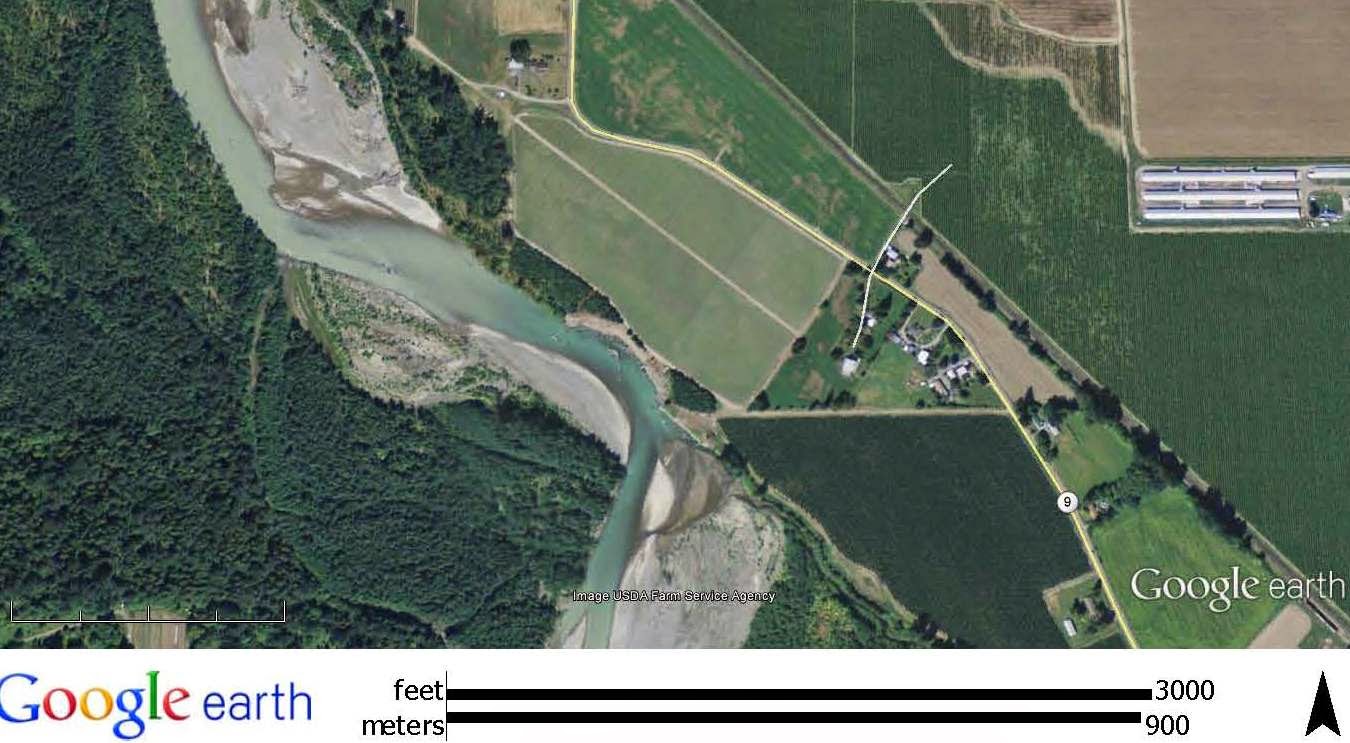A few weeks back, the Whatcom County Council approved developing a plan to use County Flood Tax dollars to shore up a river bank revetment to protect private property
whatcom-council-oks-plan-to-save-strawberry-field. The project funding is controversial for a few reasons and perhaps I'll add to it. Full disclosure: I am a member of the County Flood Advisory Committee and voted against this project.
But first a bit of an overview of the erosion location:
AERIAL/MAP HERE
This aerial view is from 2005. River flow direction is indicated with blue arrow. This section of river bank had previously been lined with rocks, but as can be seen, a small section had begun to unravel and needed to be repaired.
By 2007 the small initial failure had expanded, had not been repaired and the damaged section had begun to expand. And note that the river channel was migrating such that the main flow where the river encountered the rock revetment on the river bank was beginning to shift toward the point of damage.
By 2011, the last Google earth image, the river flow was now aimed directly at the bank where the previous small section had been damaged.
At this point the property owner had begun to do repairs using a combination of logs and rock as can be seen in the above image; however, the delay of doing the repairs had greatly expanded the area that needed repair and the rocks and amount of material used in the repair was undersized for the project.
Since 2011, the river has demolished the inadequately constructed structure and erosion reached into the farm field.
The point of erosion has been progressively moving downstream. The above picture was taken in Spring 2014 and shows the main point of erosion has shifted. An earlier area of erosion is now not confronted by the main flow of the river.
The idea that the County Flood District would fund the repair work was first raised in 2009. The project was reviewed at that time by the County Flood Advisory Committee Project Review Subcommittee. The project was scored by the committee and ranked very low relative to other potential projects. Hence, this low ranking project would very likely not be funded.
Projects that are designed to protect private property generally rank low. But if it appears that the erosion will lead to a threat to public property or put life and safety at risk, the scoring will be higher and the project may rank higher. Loss of farm land does get some consideration if the erosion will lead to loss of large tracts of farm land and more points are added to the score. There have been locations along the river where, if erosion continued, hundreds of acres of active farm land would be at risk - that is not the case at this site. Nor was it the case that the erosion posed a risk to public property or posed a life and safety risk.
In this case, none of the big threats that would move the score up were present. The project would protect only one private parcel. Public property was not at risk and the erosion and loss of farm land was relatively small scale and very localized to the individual property.
Hence, the private property owner was turned down for public funding in 2009. Unfortunately for the owner, the repair project was started too late and was not adequately sized to hold back the erosion.
The property owner then reapplied for the county to use tax dollars to fund a project to stop the erosion, but this time they have rallied supporters. They arranged field trips for County Council members and got various farmers to speak in favor of the project. Its a hard position to be in as a committee member. Groups of folks want you to fix a problem and you have tax dollars that you can use and it is very hard to say no to a property owner that is loosing land to erosion. Even with a low project score, the advisory Committee opted to vote for approval of going forward with a project to stop the erosion.
I did vote against the project. It really is too bad that as soon as the small damage location took place in 2005 the property owner did not fix the problem when it would have been a small project. The reason the County had come up with a scoring system was to attempt to get away from funding these very types of projects that only benefit a single property owner. My own geologic interpretation as well as that of Herrera is that the focus of erosion will continue to move downstream and that at some point in the next few years the river will move off the bank entirely - at least for awhile.
With the approval to work on this project the County Flood staff have developed a scheme to place large wood structures to be constructed on the bank above the river. If the river erodes to the structures, the structures would act as erosion control points. As the work would be outside the water during installation, permitting will be easier and possibly take place more readily with less mitigation. Of coarse the land owner will give up more land under this scheme and will have to agree to allow the County use of a few acres of land. The cost to do the repair will still cost $750,000. Other alternatives cost upwards to $2 million and require substantial permitting hurdles.





















































